Related Research Articles

Hubertus Gerardus Josephus Henricus "Huub" Oosterhuis was a Dutch theologian and poet. He is mainly known for his contribution to Christian music and liturgy in Dutch and also in German, used in both Protestant and Roman Catholic churches. He authored over 60 books and over 700 hymns, songs, psalms, and prayers. Several of his songs were translated, and he received international awards and recognition.

The Zuiderkerk is a 17th-century Protestant church in the Nieuwmarkt area of Amsterdam, the capital of the Netherlands. The church played an important part in the life of Rembrandt and was the subject of a painting by Claude Monet.

Amsterdam-Noord is a borough of Amsterdam, Netherlands with a population of about 90,000. The IJ, the body of water which separates it from Amsterdam-Centrum and the rest of the city, is situated southwest of Amsterdam-Noord. The borough, which has an area of 49.01 km2, borders the municipalities of Zaanstad, Oostzaan, Landsmeer and Waterland to the north, all part of the province of North Holland like Amsterdam. It borders the Markermeer to the east.
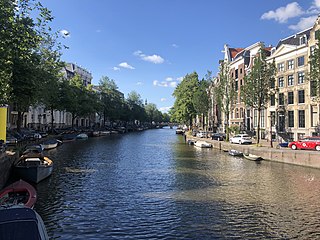
The Keizersgracht is a canal in Amsterdam, the Netherlands. It is the second of the three main Amsterdam canals that together form the Grachtengordel, or canal belt, and lies between the inner Herengracht and outer Prinsengracht.
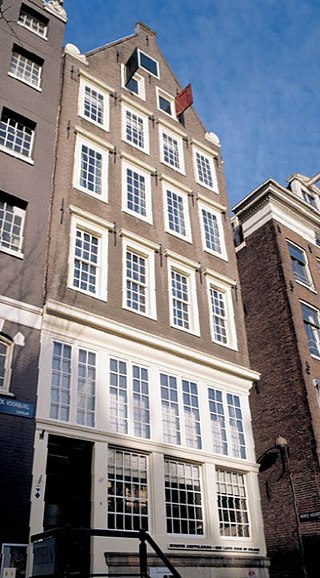
A clandestine church, defined by historian Benjamin J. Kaplan as a "semi-clandestine church", is a house of worship used by religious minorities whose communal worship is tolerated by those of the majority faith on condition that it is discreet and not conducted in public spaces. Schuilkerken are commonly built inside houses or other buildings, and do not show a public façade to the street. They were an important advance in religious tolerance in the wake of the Reformation, an era when worship services conducted by minority faiths were often banned and sometimes penalized by exile or execution.

De Bazel is a listed/protected historic building on the west side of the Vijzelstraat in Amsterdam, and stretches from the Herengracht to the Keizersgracht. It stands as an example of Brick Expressionism.

Ons' Lieve Heer op Solder is a 17th-century canal house, house church, and museum in the city center of Amsterdam, The Netherlands. The Catholic Church was built on the top three floors of the canal house during the 1660s. It is an important example of a "schuilkerk", or "clandestine church" in which Catholics and other religious dissenters from the seventeenth century Dutch Reformed Church, unable to worship in public, held services. The church has been open as a museum since 28 April 1888, and has 85,000 visitors annually.

The Proveniershuis is a hofje and former schutterij on the Grote Houtstraat in Haarlem, Netherlands.
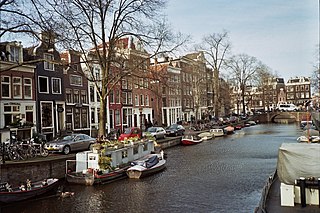
The Spiegelgracht is a canal in the centre of Amsterdam, located near the Prinsengracht. Built in the 16th century, it is a part of the Canals of Amsterdam which have been designated as UNESCO World Heritage Sites.

Felix Meritis is the name of an intellectual society in Amsterdam, but subsequently used for the building they built for themselves on the Keizersgracht.
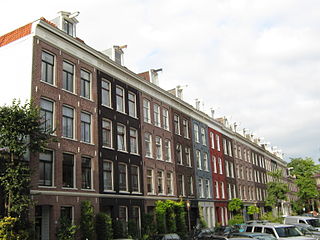
De Pijp is a neighbourhood of Amsterdam, Netherlands. It is located directly south of Amsterdam's city centre and it is part of the borough Amsterdam-Zuid, in a part of the city known as the Old South. It is served by De Pijp metro station. Most streets in De Pijp are named after Dutch painters, like Jan Steen, Frans Hals, Ruysdael and Vincent van Gogh. Diamantbuurt, Nieuwe Pijp and Oude Pijp are the three districts composing the area.
Java-eiland is a neighbourhood of Amsterdam, Netherlands. It is located on a peninsula, surrounded on three sides by water and on the east by the KNSM Island neighbourhood.
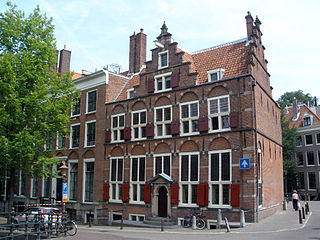
The Huis aan de Drie Grachten or Huis op de Drie Grachten is a 17th-century canal house in Amsterdam, at the southeastern end of the Wallen district. The name is a reference to the fact that the building faces three different Amsterdam canals. The south facade faces Grimburgwal, the west facade faces Oudezijds Voorburgwal and the east facade faces Oudezijds Achterburgwal. The address is Oudezijds Voorburgwal 249.

Amsterdam University Library is the library of the University of Amsterdam (UvA) and the Academic Medical Centre (AMC). The central complex of the Library is in the town centre at Singel, close to Heiligeweg and Koningsplein. The Library's Special Collections are housed nearby at Oude Turfmarkt, next to UvA's Allard Pierson Museum. The Library also has a large book depot in the grounds of the AMC, with over 40.5 kilometers of books and other materials. The foundation Friends of the Library of the University of Amsterdam regularly donates special manuscripts or rare editions to the library collection.
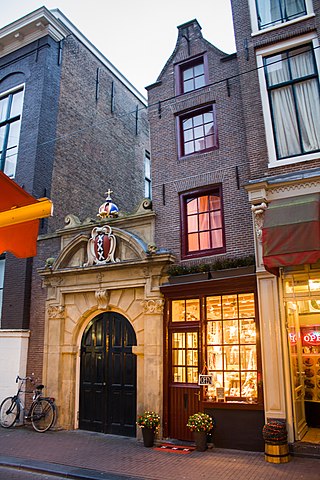
The smallest house in Amsterdam is located at Oude Hoogstraat 22 in the old city center of Amsterdam, next to the Oost-Indisch Huis and the gate to the Walloon Church. The house, by some called the "Smallest house of Europe", is 2.02 meters wide and 5 meters deep. With its distinctive spout gable, this house represents a miniature version of a typical Amsterdam canal house.
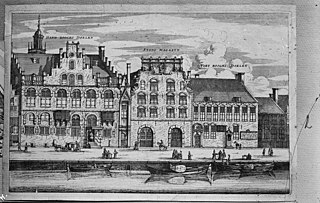
The Voetboogdoelen was a 16th-century building on the Singel canal in Amsterdam, at the corner of Heiligeweg near Koningsplein square, which served as headquarters and shooting range of the local schutterij. Frans Hals painted a group portrait for the Voetboogdoelen, known as the Meagre Company.

The Oudezijds Voorburgwal, often abbreviated to OZ Voorburgwal, is a street and canal in De Wallen in the center of Amsterdam. It runs from the Grimburgwal in the south to the Zeedijk in the north, where it changes into the Oudezijds Kolk, which drains into the IJ.
Batuta (باطوطة), is a village in northwestern Syria, located in the Jebel Sem’an region of the Dead Cities. The village was founded in the 4th century CE. By the 6th century, it had two churches and more than twelve other stone buildings. Batuta’s hilltop location, surrounded by other villages on the valley and hillsides, enabled it to serve as a center of roads across the Jebel Sem’an for the oil trade. In 2011, the village was named a UNESCO World Heritage Site as part of the Dead Cities.
References
- 1 2 3 Kaplan, Benjamin J., Religious Conflict and the Practice of Toleration in Early Modern Europe, Harvard University Press, 2007, Chapter 8, pp. 180. ff.
- ↑ Duin, Roelf Jan (18 March 2015). "Investeerder aast op debatcentrum Rode Hoed". Het Parool . Retrieved 6 February 2019.